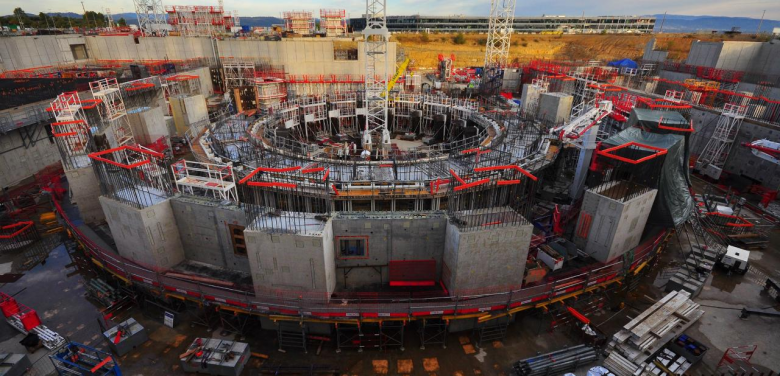
FRENCH THERMONUCLEAR REACTOR

WNN - Construction of the Iter fusion reactor, being built at Cadarache in the south of France, is now 50% complete, the Iter Organisation has announced. The reactor - construction of which began in 2010 - is scheduled to achieve first plasma in 2025.
The organisation said: "According to the stringent metrics that measure project performance, 50% of the 'total construction work scope through First Plasma' is now complete."
It said that almost 53% of construction activities (on the Iter site at Cadarache) and manufacturing activities for components and systems needed for first plasma have been completed. "The performance metrics used in Iter assign a relative weight to every activity category within the project," the organisation said. "Design, for instance, accounts for 24%; buildings construction and manufacturing for 48%; assembly and installation for 20%."
"After having compounded the percentage of completion of each category, the metrics produce a figure for the totality of the work scope through the launch of operations ('first plasma')." Design, which accounts for approximately 25% of the scope, is now close to 95% complete; manufacturing and building, which represents almost half of the total activities is close to 53% complete.
Iter Director-General Bernard Bigot said the passing of the 50% milestone reflects "the collective contribution and commitment of Iter's seven members".
Iter, which stands for International Thermonuclear Experimental Reactor, is a major international project to build a 500MW tokamak fusion device (requiring an input of 50MW) designed to prove the feasibility of fusion as a large-scale and carbon-free source of energy.
The European Union is contributing almost half of the cost of its construction, while the other six members (China, India, Japan, South Korea, Russia and the USA) are contributing equally to the rest. Under a revised schedule established by the Iter organisation last year, first plasma is planned for 2025, with deuterium-tritium fusion experiments commencing in 2035. Construction costs are expected to be around €20 billion ($22 billion), with components contributed by the Iter members on an 'in-kind' basis.
Iter's specialised components - some 10 million parts in total - are being manufactured in industrial facilities all over the world. They are subsequently shipped to the Iter worksite, where they must be assembled, piece-by-piece, into the final machine.
-----
Earlier:

2017, December, 8, 17:20:00
RUSSIA'S ROSTOV NUCLEAR STARTEDROSATOM - On the 6th of December 2017, at 19:53, the operating personnel of Rostov NPP (Volgodonsk, a branch of Rosenergoatom which is part of ROSATOM’s Power Division, the largest of all divisions) successfully loaded first fuel assemblies into the reactor of Unit 4. |

2017, December, 8, 17:05:00
BRITAIN'S NUCLEAR INDUSTRYWNN - The UK's Nuclear Industry Council (NIC) has today published its proposals for a nuclear Sector Deal. The document follows the government's publication last month of its Industrial Strategy white paper, which states the nuclear sector is "integral to increasing productivity and driving growth" in the UK.
|

2017, November, 9, 13:50:00
EIA: NUCLEAR ENERGY WILL UPEIA projects that global nuclear capacity will grow at an average annual rate of 1.6% from 2016 through 2040, led predominantly by countries outside of the Organization for Economic Cooperation and Development (OECD). EIA expects China to continue leading world nuclear growth, followed by India.
|

2017, November, 1, 08:50:00
RUSSIA - IRAN NUCLEAR ENERGYROSATOM - On the 31st of October 2017, in the Bushehr Province (Iran) the work commissioning ceremony at the main building of power unit No. 2 of Bushehr NPP (Bushehr-2 project) was held. |


